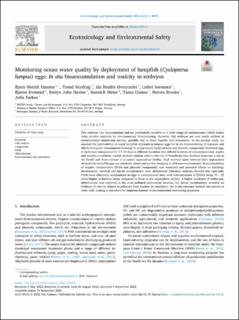| dc.contributor.author | Hansen, Bjørn Henrik | |
| dc.contributor.author | Nordtug, Trond | |
| dc.contributor.author | Øverjordet, Ida Beathe | |
| dc.contributor.author | Sørensen, Lisbet | |
| dc.contributor.author | Kvæstad, Bjarne | |
| dc.contributor.author | Davies, Emlyn John | |
| dc.contributor.author | Meier, Sonnich | |
| dc.contributor.author | Gomes, Tania | |
| dc.contributor.author | Brooks, Steven | |
| dc.contributor.author | Farkas, Julia | |
| dc.date.accessioned | 2022-10-25T06:48:29Z | |
| dc.date.available | 2022-10-25T06:48:29Z | |
| dc.date.created | 2022-10-20T10:13:53Z | |
| dc.date.issued | 2022 | |
| dc.identifier.citation | Ecotoxicology and Environmental Safety. 2022, 245, 1-12. | en_US |
| dc.identifier.issn | 0147-6513 | |
| dc.identifier.uri | https://hdl.handle.net/11250/3028074 | |
| dc.description.abstract | Fish embryos can bioaccumulate and are particularly sensitive to a wide range of contaminants, which makes them suitable sentinels for environmental biomonitoring. However, fish embryos are very rarely utilized in environmental monitoring surveys, possibly due to their fragility and seasonality. In the present work, we assessed the applicability of caged lumpfish (Cyclopterus lumpus) eggs for in situ biomonitoring of exposure and effects of organic contaminants focusing on polyaromatic hydrocarbons and phenolic compounds. Fertilized eggs (1 dpf) were transplanted for 17–19 days at different locations that differed in terms of contaminant load, depths and weather conditions, namely at three stations close to the city of Trondheim (two harbour areas and a one in the Fjord) and three stations at a coastal aquaculture facility. High survival upon retrieval after deployment showed that lumpfish eggs are relatively robust and survive encaging in different environments. Bioaccumulation of organic contaminants (PAHs and phenolic compounds) was measured and potential effects on hatching, development, survival and larvae morphometry were determined. Chemical analyses showed that especially PAHs were effectively accumulated in eggs in contaminated sites, with concentrations of ƩPAHs being 15 – 25 times higher in harbour areas compared to those at the aquaculture facility. A higher incidence of embryonic deformations was observed in the most polluted deployment location, but larvae morphometry revealed no evidence of toxicity related to pollutant body burden. In conclusion, the in-situ exposure method was proven to work well, making it attractive for implementations in environmental monitoring programs. | en_US |
| dc.language.iso | eng | en_US |
| dc.publisher | Elsevier | en_US |
| dc.rights | Navngivelse 4.0 Internasjonal | * |
| dc.rights.uri | http://creativecommons.org/licenses/by/4.0/deed.no | * |
| dc.subject | Environmental risk assessment | en_US |
| dc.subject | Alkyl-phenols | en_US |
| dc.subject | PAHs | en_US |
| dc.subject | Lumpsucker | en_US |
| dc.subject | Fish embryo | en_US |
| dc.title | Monitoring ocean water quality by deployment of lumpfish (Cyclopterus lumpus) eggs: In situ bioaccumulation and toxicity in embryos | en_US |
| dc.title.alternative | Monitoring ocean water quality by deployment of lumpfish (Cyclopterus lumpus) eggs: In situ bioaccumulation and toxicity in embryos | en_US |
| dc.type | Peer reviewed | en_US |
| dc.type | Journal article | en_US |
| dc.description.version | publishedVersion | en_US |
| dc.rights.holder | © 2022 The Authors. Published by Elsevier Inc. | en_US |
| dc.source.pagenumber | 12 | en_US |
| dc.source.volume | 245 | en_US |
| dc.source.journal | Ecotoxicology and Environmental Safety | en_US |
| dc.identifier.doi | 10.1016/j.ecoenv.2022.114074 | |
| dc.identifier.cristin | 2063110 | |
| dc.relation.project | Norges forskningsråd: 280511 | en_US |
| dc.source.articlenumber | 114074 | en_US |
| cristin.ispublished | true | |
| cristin.fulltext | original | |
| cristin.qualitycode | 2 | |

